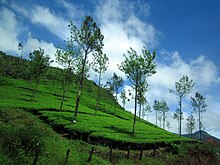Major attractions
Beaches
Flanked on the western coast by the Arabian Sea, Kerala has a long coastline of 580 km (360 mi); all of which is virtually dotted with sandy beaches.
Kovalam beach near Thiruvananthapuram was among the first beaches in Kerala to attract tourists. Rediscovered by back-packers and tan-seekers in the 1960s and followed by hordes of hippies in the 1970s, Kovalam is today the most visited beach in the state.
Other popularly visited beaches in the state include those at Kappad, Alappuzha, Marari Beach(Mararikulam, Alappuzha), Nattika (Thrissur), Vadanappilly beach (Thrissur), Cherai Beach, Beypore beach, Marari beach, Fort Kochi, and Varkala. The Muzhappilangad Beach beach at Kannur is the only drive-in beach in India. Marari beach was rated as one of the worlds top five HAMMOCK BEACH by National Geographic survey.
The backwaters in Kerala are a chain of brackish lagoons and lakes lying parallel to the Arabian Sea coast (known as the Malabar Coast).Houseboat or Kettuvallam rides in the backwaters are a major tourist attraction. Backwater tourism is centered mostly around Ashtamudi Lake, Kollam. Boat races held during festival seasons are also a major tourist attraction in the backwater regions.
The backwater network includes large lakes such as the Ashtamudi Lake, the largest among them, linked by 1500 km of canals, both man-made and natural and fed by several rivers, and extending virtually the entire length of Kerala state. The backwaters were formed by the action of waves and shore currents creating low barrier islands across the mouths of the many rivers flowing down from the Western Ghats range.
Hill stations
Eastern Kerala consists of land encroached upon by the Western Ghats; the region thus includes high mountains, gorges, and deep-cut valleys. The wildest lands are covered with dense forests, while other regions lie under tea and coffee plantations (established mainly in the 19th and 20th centuries) or other forms of cultivation.
The Western Ghats rise on average to 1500 m elevation above sea level. Some of the popular hill stations in the region are Munnar, Vagamon, Paithalmala, Wayanad, Nelliyampathi, Elapeedika,Peermade, Thekkady and Ponmudi.
Wildlife
Most of Kerala, whose native habitat consists of wet evergreen rainforests at lower elevations andhighland deciduous and semi-evergreen forests in the east, is subject to a humid tropical climate. However, significant variations in terrain and elevation have resulted in a land whose biodiversityregisters as among the world’s most significant. Most of Kerala's significantly biodiverse tracts of wilderness lie in the evergreen forests of its easternmost districts. Kerala also hosts two of the world’sRamsar Convention-listed wetlands: Lake Sasthamkotta and the Vembanad-Kol wetlands are noted as being wetlands of international importance. There are also numerous protected conservation areas, including 1455.4 km2 of the vast Nilgiri Biosphere Reserve. In turn, the forests play host to such major fauna as Asian elephant (Elephas maximus), Bengal tiger (Panthera tigris tigris), leopard(Panthera pardus), Nilgiri tahr (Nilgiritragus hylocrius), and grizzled giant squirrel (Ratufa macroura).[16] More remote preserves, including Silent Valley National Park in the Kundali Hills, harbour endangered species such as the lion-tailed macaque (Macaca silenus), Indian sloth bear(Melursus (Ursus) ursinus ursinus), and gaur (the so-called "Indian bison"—Bos gaurus). More common species include Indian porcupine(Hystrix indica), chital (Axis axis), sambar (Cervus unicolor), gray langur, flying squirrel, swamp lynx (Felis chaus kutas), boar (Sus scrofa), a variety of catarrhine Old World monkey species, gray wolf (Canis lupus), and common palm civet (Paradoxurus hermaphroditus). Many reptiles, such as king cobra, viper, python, various turtles and crocodiles are to be found in Kerala—again, disproportionately in the east. Kerala's avifauna include endemics like the Sri Lanka frogmouth (Batrachostomus moniliger), Oriental bay owl, large frugivores like the great hornbill (Buceros bicornis) and Indian grey hornbill, as well as the more widespread birds such as peafowl, Indian cormorant, jungle and hill myna, Oriental darter, black-hooded oriole, greater racket-tailed and black drongoes, bulbul (Pycnonotidae), species of kingfisher and woodpecker, jungle fowl, Alexandrine parakeet, and assorted ducks and migratory birds. Additionally, freshwater fish such as kadu (stinging catfish—Heteropneustes fossilis) and brackishwater species such as Choottachi (orange chromide—Etroplus maculatus, valued as an aquarium specimen) also are native to Kerala's lakes and waterways.
Waterfalls
- Adyanpara Falls, near Nilambur
- Aruvikkuzhi, near Maramon, Kozhencherry in Pathanamthitta District
- Aruvikkuzhi, near Pallickathode, Kottayam District
- Athirappilly Falls 80 ft (24 m)
- Charpa Falls
- Cheeyappara Falls, near Adimali
- Chethalayam Falls, in Wayanad
- Kumbhavurutty Falls in Kollam district
- Lakkom Water Falls
- Madatharuvi Falls, near Ranny in Pathanamthitta District
- Marmala waterfall
- Meenmutty Falls, Thiruvananthapuram
- Meenmutty Falls 984 ft (300 m), in Wayanad
- Mulamkuzhi, near Malayattoor in Ernakulam District
- Panieli Poru waterfalls Ernakulam
- Palaruvi Falls, 300 ft (91 m) in Aryankavu near Punalur in Kollam district
- Pattathippara Falls
- Perunthenaruvi Falls
- Siruvani Waterfalls Palakkad
- Soochipara Falls 656 ft (200 m) / Sentinelrock falls, in Wayanad
- Thommankuthu Falls, near Thodupuzha
- Thusharagiri Falls
- Valara Falls, near Adimali
- Vazhachal Falls, near Athirappilly
- Vazhvanthol waterfalls Trivandrum
Lighthouses
Lighthouses are the main centre of attractions of Kerala beaches and coast line. There are 15 lighthouses in the entire state of Kerala. Districts of Kollam, Kannur, Kozhikode, Alappuzha, Thrissur and Thiruvananthapuram have more than one lighthouse.[18]
- Major Lighthouses
- Vizhinjam lighthouse, Thiruvananthapuram
- Anjengo lighthouse, Thiruvananthapuram
- Tangasseri Lighthouse, Kollam (Tallest in the state)
- Kovilthottam Lighthouse, Kollam
- Alappuzha Lighthouse, Alappuzha
- Manakkodam Lighthouse, Alappuzha
- Cochin Lighthouse, Ernakulam
- Azhikode Lighthouse, Thrissur
- Chetwai Lighthouse, Thrissur
- Ponnani Lighthouse, Malappuram
- Beypore Lighthouse, Kozhikode
- Kozhikode lighthouse, Kozhikode (Defunct)
- Cannanore Lighthouse, Kannur
- Mount Dilly Lighthouse, Kannur
- Kasargode Lighthouse, Kasargode











Each and every place details will be added soon,,, You can ask about the tourist places that you want to know About..
ReplyDeleteThank you